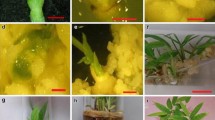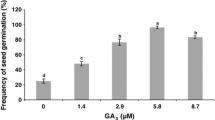Summary
Single cells were obtained from hypocotyl-derived callus ofLavandula latifolia Medicus. Cells were plated in Murashige and Skoog medium supplemented with indoleacetic acid (IAA), benzyladenine (BA), and several IAA-BA combinations. Cell division required the simultaneous presence of IAA and BA in the culture medium, but callus formation was only achieved with 0.1 or 1 mg/liter IAA and 2 mg/liter BA. To induce organogenesis, calli were transferred to various regeneration media. Shoot-bud differentiation efficiency depended on the composition of both the callus induction and the shoot regeneration media, best results being obtained when calli grown in 1 mg/liter IAA and 2 mg/liter BA were subcultured to media containing 2 mg/liter BA and 15% coconut milk. Under these conditions, up to 75% of calli formed shoots that subsequently were rooted and established in soil.
Similar content being viewed by others
References
Bergmann, L. Growth and division of single cells of higher plants in vitro. J. Gen. Physiol. 43:841–851; 1960.
Binding, H.; Nehls, R.; Jörgensen, J. Protoplast regeneration in higher plants. In: Fujiwara, A., ed. Plant tissue culture 1982. Tokyo: The Japanese Association for Plant Tissue Culture; 1982:575–578.
Brisa, M. C.; Segura, J. Isolation, culture and plant regeneration from mesophyll protoplasts ofDigitalis obscura. Physiol. Plant. 69:680–686; 1987.
Calvo, M. C. Segura, J. In vitro morphogenesis from explants ofLavandula latifolia andLavandula stoechas seedlings. Scientia Hortic. In Press; 1988.
Font-Quer, P. Plantas medicinales, 4th ed. Barcelona: Labor Press; 1978; 656–657.
Fujita, Y.; Tabata, M. Secondary metabolites from plant cells: pharmaceutical applications and progress in commercial production. In: Green, G. E.; Somers, D. A.; Hackett, W. P., et al., eds. Plant tissue and cell culture. New York: Alan R. Liss; 1987:169–185.
Gomez, M. P.; Calvo, M. C.; Segura, J. Callus formation from hypocotyl ofLavandula stoechas: interaction between nutritional and hormonal factors. Gartenbauwissenschaft 52:6–9; 1987.
Gomez, M. P.; Calvo, M. C.; Cornejo, M. J., et al. Isolation and culture ofLavandula stoechas cells. Plant Physiol. (Life Sci. Adv.) 6:159–164; 1987.
Murashige, T.; Skoog, T. A revised medium for rapid growth and bioassays with tobacco tissue cultures. Physiol. Plant. 15:473–497; 1962.
Whitaker, R. J.; Hashimoto, T. Production of secondary metabolites. In: Evans, W. R.; Sharp, P. V.; Ammirato, P. V., eds. Handbook of plant cell culture, vol. 4. New York: Macmillan; 1986:264–286.
Yamada, Y.; Hashimoto, T. Secondary products in tissue culture. In: Collins, G. B.; Petolino, J. G., eds. Applications of genetic engineering to crop improvement. Dordrecht: Martinus Nijhoff/Dr. W. Junk Publishers; 1984:561–604.
Author information
Authors and Affiliations
Rights and permissions
About this article
Cite this article
Calvo, M.C., Jordan, A. & Segura, J. Plant regeneration from isolated cells ofLavandula latifolia medicus. In Vitro Cell Dev Biol 24, 943–946 (1988). https://doi.org/10.1007/BF02623907
Received:
Accepted:
Issue Date:
DOI: https://doi.org/10.1007/BF02623907




